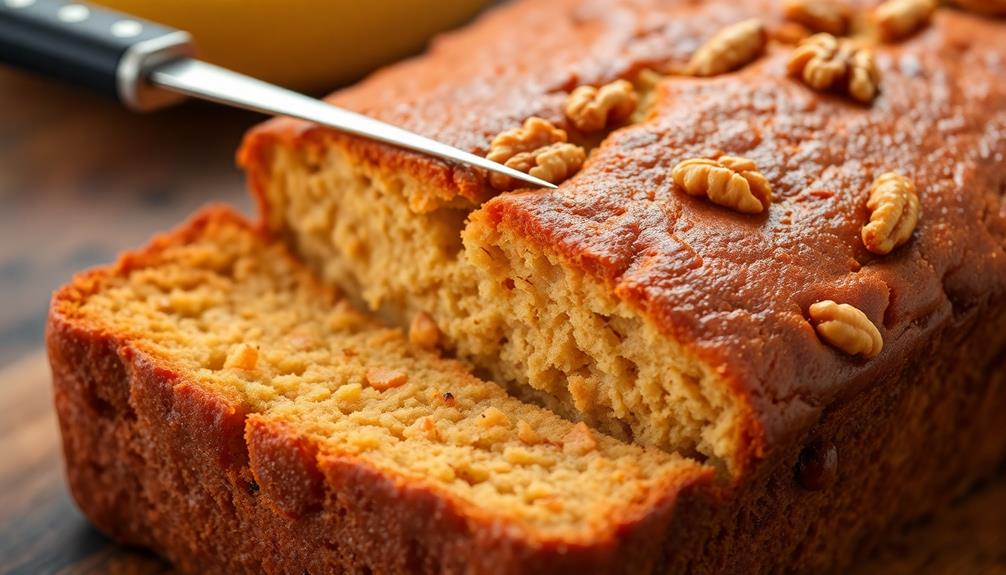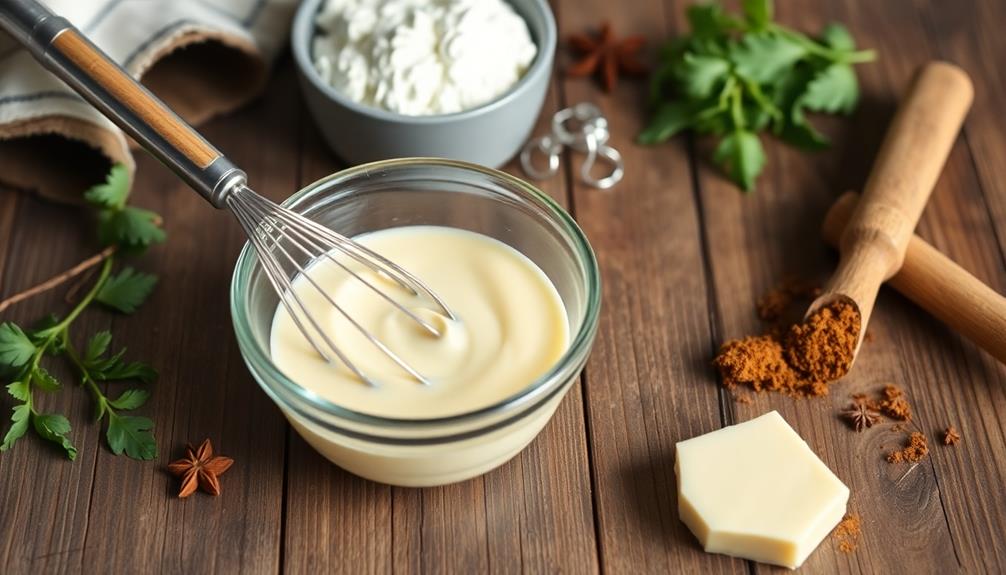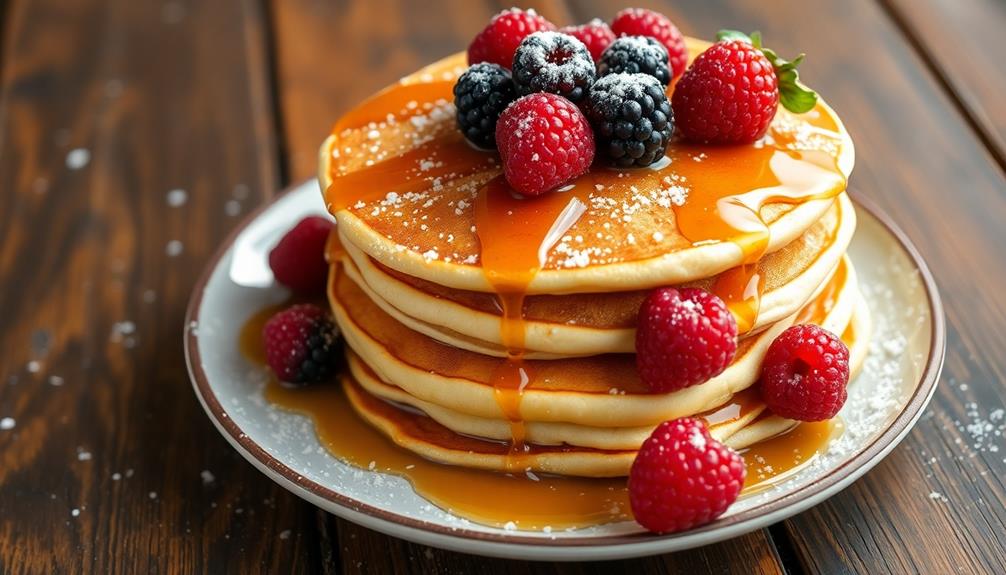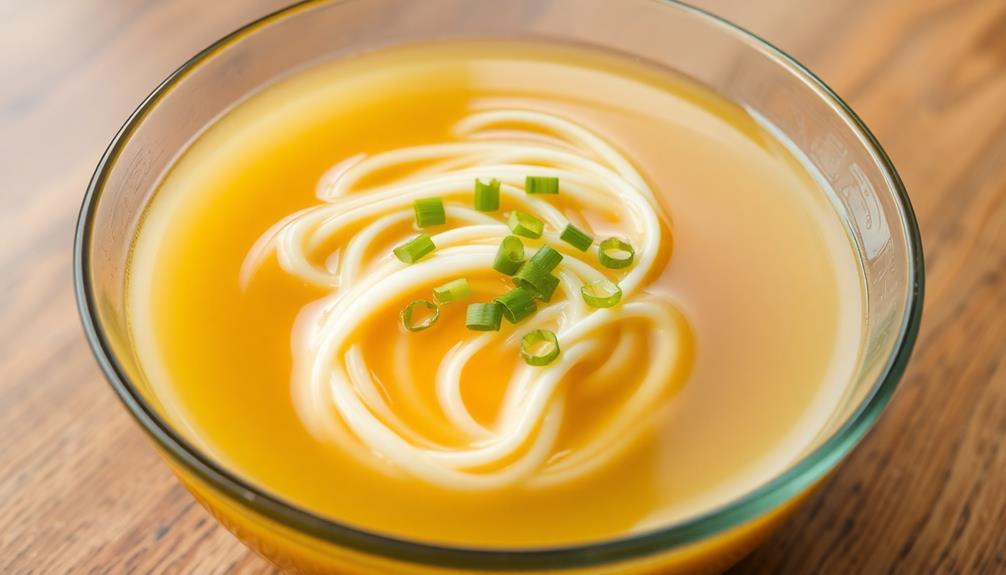Fluffy scrambled eggs are a beloved breakfast classic with a history dating back centuries, but their modern preparation yields a light, airy texture. Start by lightly beating the eggs to incorporate air and create a frothy mixture. Gently whisk in milk or cream, then melt unsalted butter in a skillet over low heat. Pour in the egg mixture and use a gentle folding motion to cook the eggs, avoiding vigorous stirring. Remove from heat while slightly underdone, as the eggs will continue cooking off the heat. Master this timeless dish with a few simple techniques – and you'll discover even more ways to elevate your scrambled eggs.
Key Takeaways
- Whisk eggs thoroughly to incorporate air and create a frothy mixture for optimal fluffiness.
- Cook over low heat, gently folding the eggs to maintain a soft and creamy texture.
- Use a non-stick pan and sufficient butter to prevent sticking and enhance flavor.
- Remove the eggs from heat slightly before they appear fully cooked, as they will continue to cook off the heat.
- Customize the dish with mix-ins like vegetables, herbs, or cheese to suit personal preferences.
History

Although the origins of scrambled eggs can be traced back centuries, the fluffy, creamy version we enjoy today emerged relatively recently. Throughout history, various cultures have developed their own unique takes on egg-based dishes, from the ancient Chinese "hundred-year eggs" to the beloved Spanish tortilla.
However, the modern fluffy scrambled eggs we know and love didn't gain widespread popularity until the early 20th century.
The key to achieving that light and airy texture lies in the method. Slowly cooking the eggs over low heat, while constantly stirring and incorporating air, creates the signature fluffy result. This technique was championed by chefs and home cooks alike, as it produced a far more delicate and appealing dish than the dense, rubbery scrambles of the past.
Today, fluffy scrambled eggs have become a breakfast staple, beloved for their simple yet satisfying nature. With the right approach, you too can master this timeless recipe and enjoy a taste of culinary history.
Recipe

Fluffy scrambled eggs are a breakfast classic that can be enjoyed any time of day. The key to achieving the perfect light and airy texture is to gently cook the eggs over low heat, while incorporating a bit of cream or milk. This simple recipe will guide you through the process, ensuring you end up with a delicious and visually appealing plate of scrambled eggs.
Scrambled eggs are a versatile dish that can be customized with a variety of mix-ins, from sautéed vegetables to crumbled bacon. The possibilities are endless, making this a great option for those who enjoy experimenting in the kitchen.
- 4 large eggs
- 2 tablespoons milk or cream
- Salt and pepper to taste
- 1 tablespoon unsalted butter
In a medium bowl, whisk together the eggs and milk or cream until well combined. Season with salt and pepper.
Melt the butter in a nonstick skillet over low heat. Pour in the egg mixture and use a spatula to gently push the eggs around the pan, forming large, fluffy curds. Cook until the eggs are soft and creamy, about 3-4 minutes, being careful not to overcook.
For the fluffiest scrambled eggs, avoid vigorous stirring or high heat, which can result in rubbery, dry eggs. Serve the eggs immediately for the best texture and flavor.
Cooking Steps
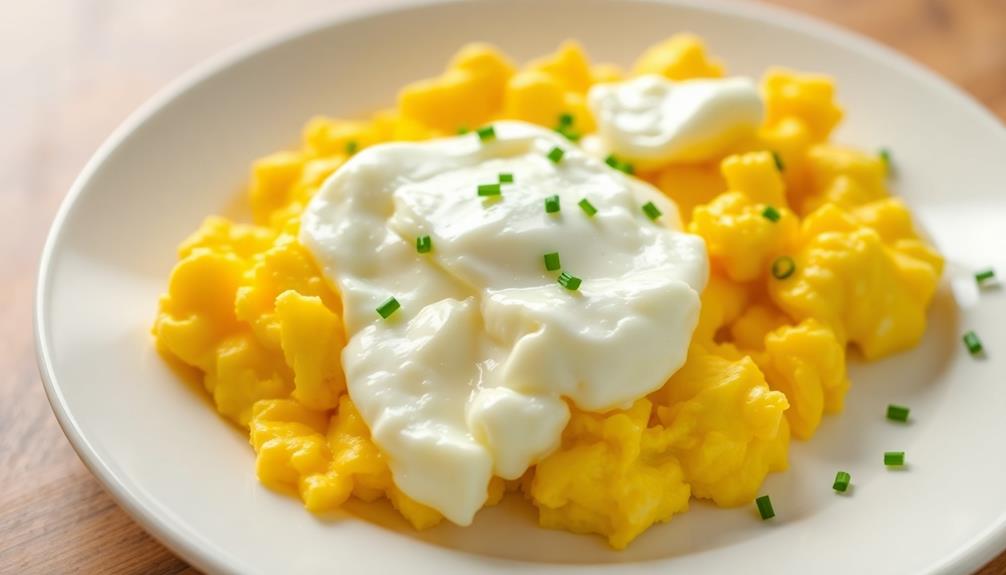
Crack your eggs into a bowl and whisk them until they're well blended.
Next, melt some butter in a skillet over medium heat.
Pour the egg mixture into the skillet and gently fold the eggs as they cook, creating soft, fluffy scrambled eggs.
Step 1. Crack Eggs Into a Bowl
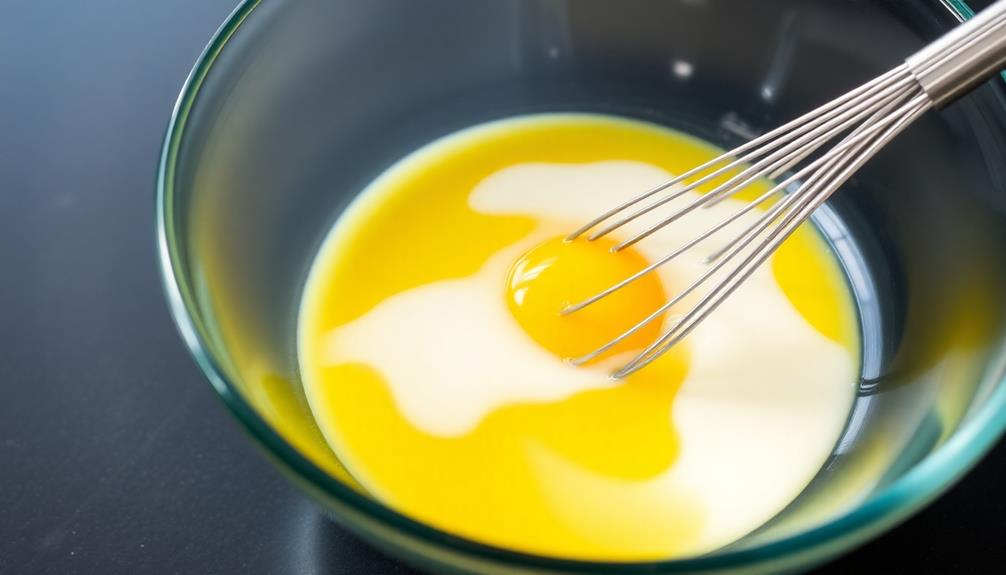
To begin, crack the eggs gently into a medium-sized bowl. Ensure that you don't let any bits of eggshell fall in. Gently separate the eggs, one at a time, over the bowl, allowing the yolk and white to drop in. Avoid cracking the eggs directly into the bowl, as this can cause the yolks to break prematurely.
Once all the eggs are in the bowl, take a fork or whisk and lightly beat the eggs. Don't overbeat them – you want the mixture to be slightly frothy, with some visible streaks of yolk and white. Beating the eggs too much can make them tough and rubbery. This step is crucial for achieving the right texture, especially if you’re using the eggs for recipes or dishes that rely on their delicate consistency. Whether you’re making a scramble or aiming for perfect hardboiled eggs every time, proper egg preparation sets the foundation for success. Take your time and enjoy the process—it makes all the difference!
If you'd like to add any additional ingredients, such as milk, cream, or seasonings, now is the time to do so. Gently incorporate them into the egg mixture until everything is well combined.
Be careful not to over-mix, as this can also affect the texture of the final scrambled eggs.
Step 2. Whisk Eggs Until Well Blended
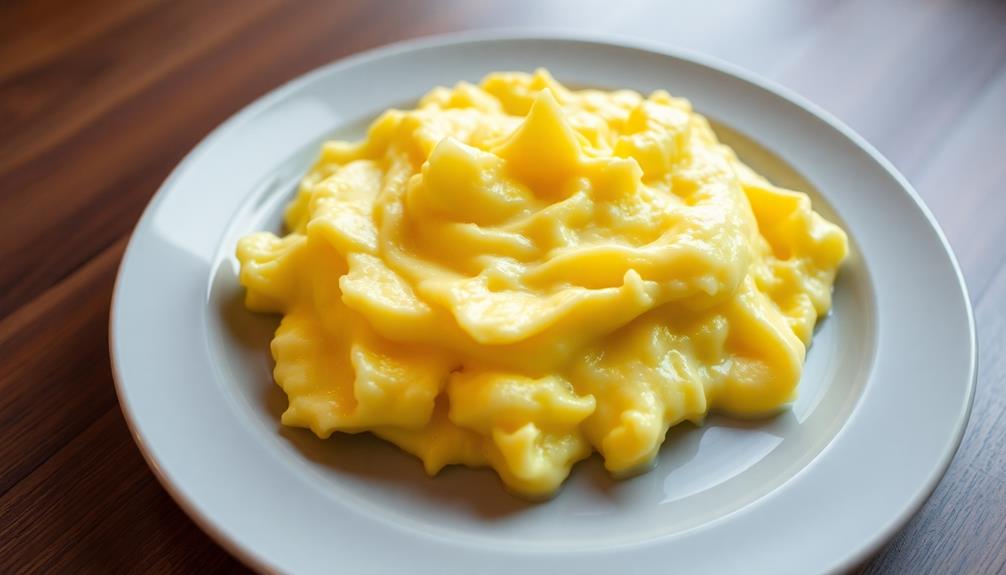
With the eggs gently whisked, it's time to begin cooking. Whisk the eggs vigorously until they're well blended and have a consistent, uniform texture. This process incorporates air into the mixture, resulting in fluffier, more tender scrambled eggs.
Go for a steady, rhythmic motion, making sure to hit every corner of the bowl. The goal is to create a smooth, homogeneous batter without any visible streaks of yolk or white. This thorough whisking helps the eggs cook evenly and prevents rubbery or uneven textures.
- Whisk the eggs briskly for 30 seconds to 1 minute, until the mixture is light and frothy.
- Avoid over-whisking, as this can make the eggs tough and dense.
- Pause occasionally to scrape down the sides of the bowl, ensuring all the egg is incorporated.
- Listen for the distinctive "ribbon" sound the whisk makes as it moves through the liquid – this indicates the eggs are well blended.
Once the eggs are perfectly whisked, they're ready for the next step: cooking to fluffy perfection.
Step 3. Melt Butter in Skillet
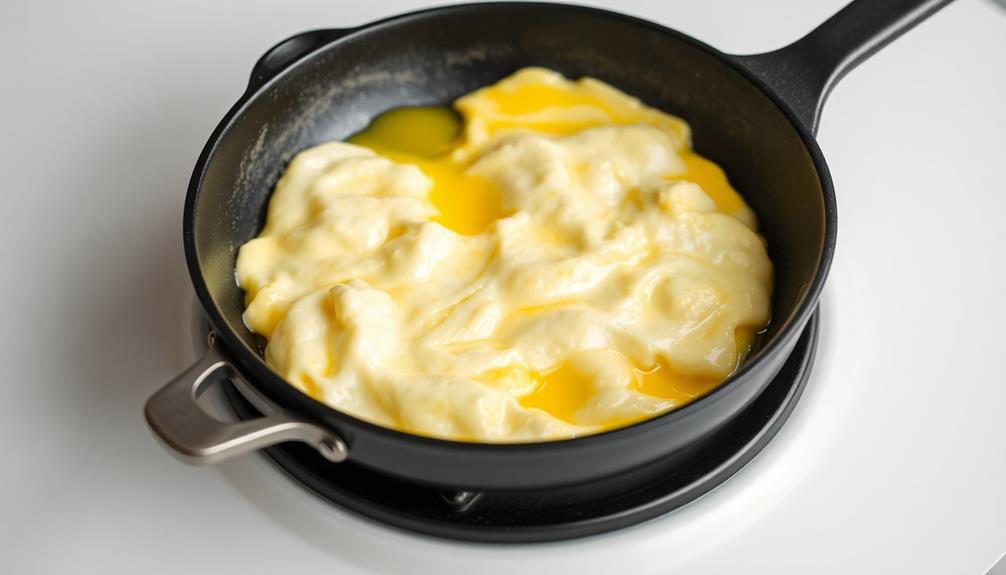
Heat a nonstick skillet over medium heat. Once the pan is hot, add a small knob of butter and let it melt, swirling the pan to coat the surface. The butter should melt slowly and evenly, without sizzling or browning. This gentle melting helps create the silky, creamy texture that makes fluffy scrambled eggs so delightful.
- Use a generous amount of butter, around 1 to 2 tablespoons per 2-3 eggs. The butter not only adds rich flavor, but also helps prevent the eggs from sticking to the pan.
- If the butter starts to sizzle or brown, the heat is too high. Adjust the temperature down slightly to maintain a gentle, steady melting.
Once the butter is fully melted, you're ready to add the whisked eggs and begin gently stirring and folding them in the pan.
Step 4. Pour Egg Mixture Into Skillet

Once the butter has fully melted, you can pour the whisked eggs into the skillet. Be sure to pour the egg mixture in a circular motion, starting from the outside and working your way inward. This helps to evenly distribute the eggs across the surface of the pan.
As the eggs begin to set, use a spatula to gently push and fold the eggs from the outside of the pan toward the center. This gentle folding motion will help create the fluffy, soft texture you're looking for in perfectly scrambled eggs.
Avoid vigorous stirring, as this can result in rubbery or dry eggs. Continue this folding process, lifting and gently stirring the eggs, until they reach your desired doneness.
Keep in mind that the eggs will continue to cook even after you remove them from the heat, so it's best to take them off the stove when they're still slightly underdone. Transfer the fluffy scrambled eggs to a plate and serve immediately.
Step 5. Gently Fold Eggs Until Cooked
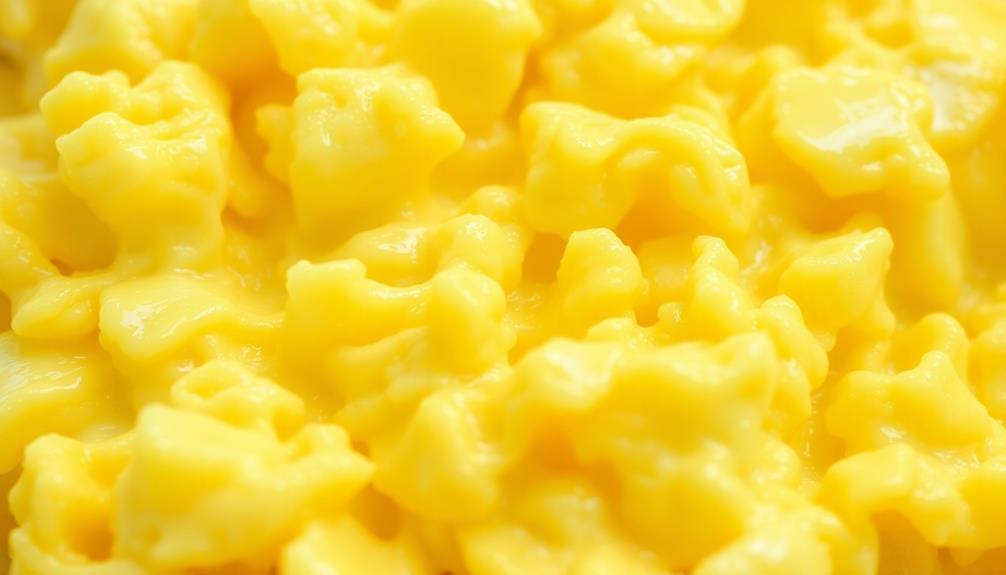
As the eggs begin to set, use a spatula to gently push and fold the eggs from the outside of the pan toward the center. This slow, careful technique helps create the signature fluffy texture of scrambled eggs.
Don't be tempted to stir vigorously, as that can result in dry, rubbery eggs. Instead, use gentle lifting and folding motions to allow the uncooked eggs on top to flow down to the bottom of the pan.
Continue this process, folding the eggs every 20-30 seconds, until they reach your desired level of doneness. You'll know they're ready when they're softly set but still have a slightly moist, creamy appearance.
Be mindful not to overcook, as that can make the eggs tough. Finish by removing the pan from the heat and giving the eggs one final gentle fold to incorporate any remaining uncooked portions.
Final Thoughts
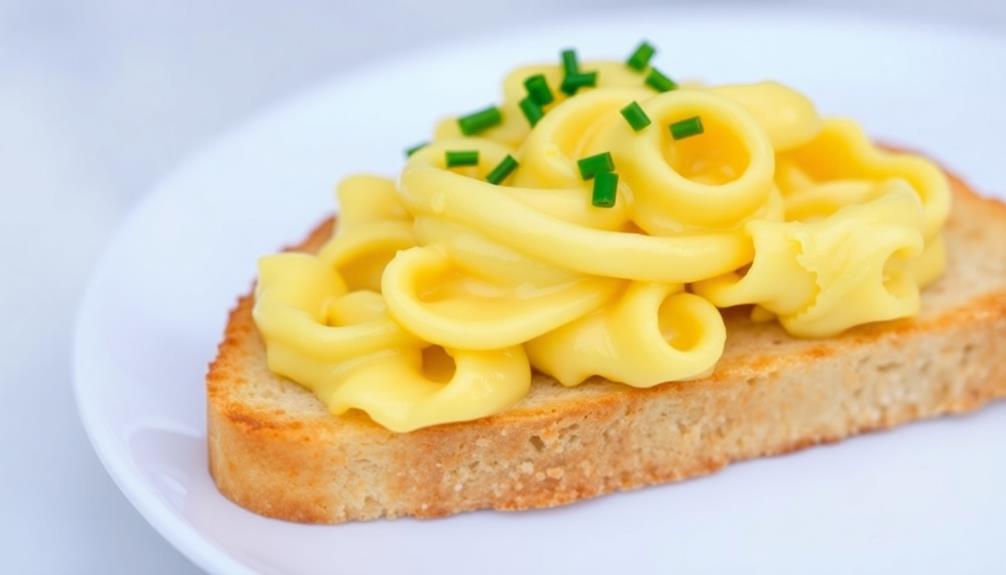
With a delectable plate of fluffy scrambled eggs now before you, the final thoughts on this recipe should resonate. Crafting the perfect scrambled eggs takes patience and precision, but the end result is well worth the effort. The key is low, steady heat, allowing the eggs to cook gently, resulting in a creamy and light texture. For anyone wondering *how to make scrambled eggs* that are truly exceptional, remember that timing and technique are essential. Mastering these steps will elevate this simple dish into a breakfast masterpiece you’ll want to recreate time and again.
The keys to achieving that light and airy texture are gentle folding and maintaining a moderate heat throughout the cooking process.
As you savor each bite, consider how the addition of a few simple ingredients – butter, a splash of milk, and a pinch of salt and pepper – can transform the humble egg into a sublime breakfast or brunch staple.
The contrasting flavors and textures create a harmonious blend that's both comforting and indulgent.
Looking ahead, you may wish to experiment with mix-ins such as diced vegetables, herbs, or a sprinkle of cheese to further customize your scrambled eggs to your taste.
Ultimately, the true joy lies in the process of perfecting this timeless dish and sharing it with loved ones. Bon appétit!
Frequently Asked Questions
What Is the Best Type of Pan to Use?
To make the best fluffy scrambled eggs, you'll want to use a non-stick skillet. The smooth surface allows the eggs to slide and fold easily, resulting in a light and airy texture.
Can I Use a Different Type of Milk?
You can certainly use a different type of milk in your scrambled eggs. Cow's milk, almond milk, oat milk, or even coconut milk can work well, each imparting its own unique flavor and texture to the dish.
How Do I Prevent the Eggs From Getting Rubbery?
To prevent eggs from getting rubbery, whisk them well before cooking, use low heat, and don't overcook. Stir the eggs frequently and remove them from the heat when they're still slightly wet.
How Long Can I Store Leftover Scrambled Eggs?
You can typically store leftover scrambled eggs in the refrigerator for 3-4 days. Be sure to store them in an airtight container and reheat them gently to prevent them from becoming dry or rubbery.
Can I Add Other Ingredients to the Scrambled Eggs?
You can absolutely add other ingredients to your scrambled eggs! Feel free to experiment with cheese, veggies, herbs, or even leftover meats. Get creative and make the scrambled eggs your own.

